Dear Creative Soul,
I am baking baguettes this afternoon, using a recipe given to me by a French baker I met a few years back. Later, I will serve them with Sticky coconut rice cake with turmeric tomatoes, a recipe my husband and I adore from Mezcla by Ixta Belfrage. The turmeric tomato sauce calls out for mopping up with crusty bread. And as the baguettes prove between folds of a linen baker’s couche, I am reminded of Michel, our Airbnb host in Strasbourg who bought us fresh baguettes and pastries from a different bakery every morning of our stay. We ate them with French butter and his home-made fig jam, with soft cheese we bought from a nearby market, with thickly sliced brown mushrooms cooked in butter and seasoned with sel et poivre … we didn’t waste a crumb.
Soon my house will fill with the smell of baking bread, and I will be whisked back to Strasbourg, Alsace, where we stayed for five days. Veux-tu me rejoindre? Will you join me?
Travel bouquets
The sun has barely risen when we drag our slightly-heavier suitcases to Munich Hauptbahnhof. Our hosts have delivered a bag of pastries for our journey - croissant au beurre and pain au chocolat - and we save these for the train that will take us to Stuttgart and our connection to Strasbourg. As the train moves from city to country, flashing past frost-coated fields, we order hot drinks and bite into buttery, flaky pastry, eyes closing in pleasure. We have started as we will go forward for the next few days, and we don’t yet know it.
Arriving in Strasbourg is disconcerting: the second-largest station in France, it has a chaotic energy that gets under our skin as we look for the exit, a toilet, a taxi. Anticipation gives way to mild anxiety as we follow the crowd the wrong way, double back to the entrance, eyes darting here, there, everywhere; we drink in unfamiliar sights and sounds while wondering where the heck the taxis are. The traffic is so heavy it takes forty-five minutes to drive 3.5 kilometres to the historic Krutenau district. Welcome to Strasbourg, the taxi driver says after we have been sitting at the same set of traffic lights for fifteen minutes. Yes, this is normal, but also, the Christmas markets, he clarifies - everyone is here: tourists, locals, tout le monde! We look at each other, perplexed. We knew Strasbourg would be crowded close to Christmas - as much as you can know from reading online articles and blog posts - but as the taxi inches past one salon de coiffure after another, past nothing that looks remotely Christmassy or like the photos we’ve seen, we feel once more out of our depth. Impatient to get moving, to feel, hear, see and taste.
Our misgivings disappear once we arrive at our Airbnb, a charming apartment in a 16th-century Alsatian house. Michel, our host who is “passionate about old stones”, has combined comfort and tradition to create a bright, warm and welcoming space decorated with objects made by local craftspeople. He has thought of everything: coffee, fruit, pretzels, yoghurt, milk, butter, the aforementioned fig jam, a bottle of wine. We don’t want to leave, but we are here to explore and so, refreshed and fed, we venture out into the village-like atmosphere of Krutenau, once a fishermen’s district, now a trendy neighbourhood with small cafés and quirky bookstores. We wind past half-timbered houses and the remains of ancient medieval fortifications to the quays, stroll along Quay des Bateliers, escape the crowds by disappearing up and down alleys with boutique shops and restaurants that are closed for the afternoon. The air of festive anticipation is infectious, but after seeing the throngs of people crossing picturesque bridges to the Grand-Île and La Petite France, through tight security and past watchful police, we retreat into the Alsatian Museum where history awaits. The Christmas markets will wait, we decide as we eat Lebanese moussaka and drink vin du Liban, but we can’t resist a peek at the glittery lights before our feet wear out.
In the morning, the city is shrouded in fog, blurring the edges, softening the early light; we turn right and head along the water’s edge to St Paul’s Church, a neo-Gothic landmark on the tip of Île Sainte-Hélène, stopping to chat with an American traveller who overhears our English. We walk on, around the church, across the bridge and along near-deserted alleys; the air is bitter, our breath plumes in clouds of white, our fingertips freeze and nothing is open. Near the Cathedral of Notre Dame, people are congregating and queuing outside closed cafés, while others line up for the church service. We finally find a tiny café run by a brusque Italian woman, who reserves her smiles for locals with friendly dogs; we discard beanies, coats, gloves and revive our fingers by wrapping them around steaming mugs of hot chocolate. The woman almost smiles when I tell her in slow French that it is very good.
Back at the cathedral, we join the growing throng of open-mouthed admirers, gaping at the stunning Gothic masterpiece that looms above the square and disappears into fog. It is a timeless work of art: delicate yet monumental, exquisite and intricate. Her colours are mist-muted but her magnificence roars.
Strasbourg at Christmas smells of sugar and spice and all things nice: cinnamon, nougat. sugar-coated nuts, chocolate grilled meat, bread, ginger, honey, cheese, wine. We follow our noses down side streets, into shops that make our tastebuds dance; we have tried to avoid the crowds but find that this is impossible at this time of the year. We stop at a flea market, pick up random items that catch our eye while mentally converting euros to AUD; I wonder at the stories behind some of the items and their owners. Where are they now? I buy a vintage Alsatian vase, grey and blue, that will later sit on my writing desk, contemplate a painting that waits proudly on an easel. In La Petite France, we warm our hands by a fire pit at a small Advent Market, then cross a bridge and find ourselves in the midst of a heaving mosh pit at another Christmas market. It is no place for lingering, not for two introverts, and we escape down another side street and breathe.
We walk around the Grand-Île, skirting around stylish and impracticably dressed people posing for Instagram content, past expensive department stores and high-end boutiques way out of our price bracket. Daylight fades, but the city sparkles; it is magical, bewitching, enchanting, every step a twinkling discovery. There are homeless people huddled in doorways, tents erected under bridges. Visible yet invisible, and I wonder how these people see us or if we are invisible to them too.
We came to travel later in life; our nest is empty and our birds have flown, and so we are flying too. But we are not bucket list travellers - we have no desire to rush from place to place. We linger longer, content to stay a few days, to spend “a lot of time in one place instead of a little time in many”. One night, after a couple of days’ exploring, of seeing this city in different lights - the grey fog, the pink sunrise, the golden glow of sunset - we talk about slow travel, and how we like to engage with whatever world we find ourselves in. We find ourselves wanting to connect, going to the same restaurant because we like the food and the people, going to the same café and grocery store, striking up conversations, looking for opportunities to test our language skills. Our story, our adventure, is not plotted in advance (aside from train travel and accommodation), but unfolds with possibility each day.
“It’s about taking the time to make a connection—to the land and each other,” says Chyanne Trenholm
We walk to the station and catch early trains to Obernai and to Colmar, gorgeous Alsatian towns with cobblestoned streets and colourful half-timbered buildings of medieval provenance. We explore these textured towns on foot, venturing as far as we can to discover parks, creeks, gardens, vineyards on terraces. In Colmar, we cruise along the canal in a gondola, buy crisp apples in a market, and taste honeyed-nougat cut from thick wedges. We eat lunch in a crowded Winstub - rösti for me, choucroute for my husband - and strike up conversations with fellow diners, a couple from France on one side, a Belgian family on the other. They want to know about kangaroos; I show them photos of a recent kangaroo and emu encounter.
Christmas is all around us, but so too are the reminders of the world’s darker side. We are at a small Christmas market in Colmar; leaning on a wall above are police, their eyes watchful, guns ready. We are at the station in Strasbourg: unsmiling police and military walk up and down platforms in groups of three or four. We are walking back to our apartment; there are checkpoints at every bridge, vans parked along the quay.
It is raining softly and, despite my limited French, I have ventured out on my own; I have a loose plan of finding an exquisite item in a French charity or thrift shop, but such shops in Strasbourg prove not to be a place of bargains. My fingers linger on a warm vintage coat I don’t need, they trail down the soft leather of a vintage handbag. I browse at a flea market and discover a Christmas market we somehow missed on earlier walks; I say bonjour and merci and bonne journée and find my way back to the apartment as if this city is my own. And just as I’m about to message my husband, to suggest we meet for coffee and cake at a café nearby, I look up - there he is, on the other side of the road, waiting with a smile.
On our final night we venture to the Christmas market after dark. It’s a glittering fairytale village, with hundreds of wooden stalls bedecked in lights and enticing smells that tempt our already full bellies; it’s busy, but not so much that we feel uncomfortable. We buy Christmas ornaments and table linen, drink mulled wine and taste gingerbread; we people watch and drink in the festive atmosphere. And then we weave our way through the cobbled streets, across the bridge, tracing a path we have come to know well, and end our evening with a glass of wine and squares of dark chocolate, talking about coming back before we have even gone.
Next stop: Singhofen (aka, somewhere in the German countryside).






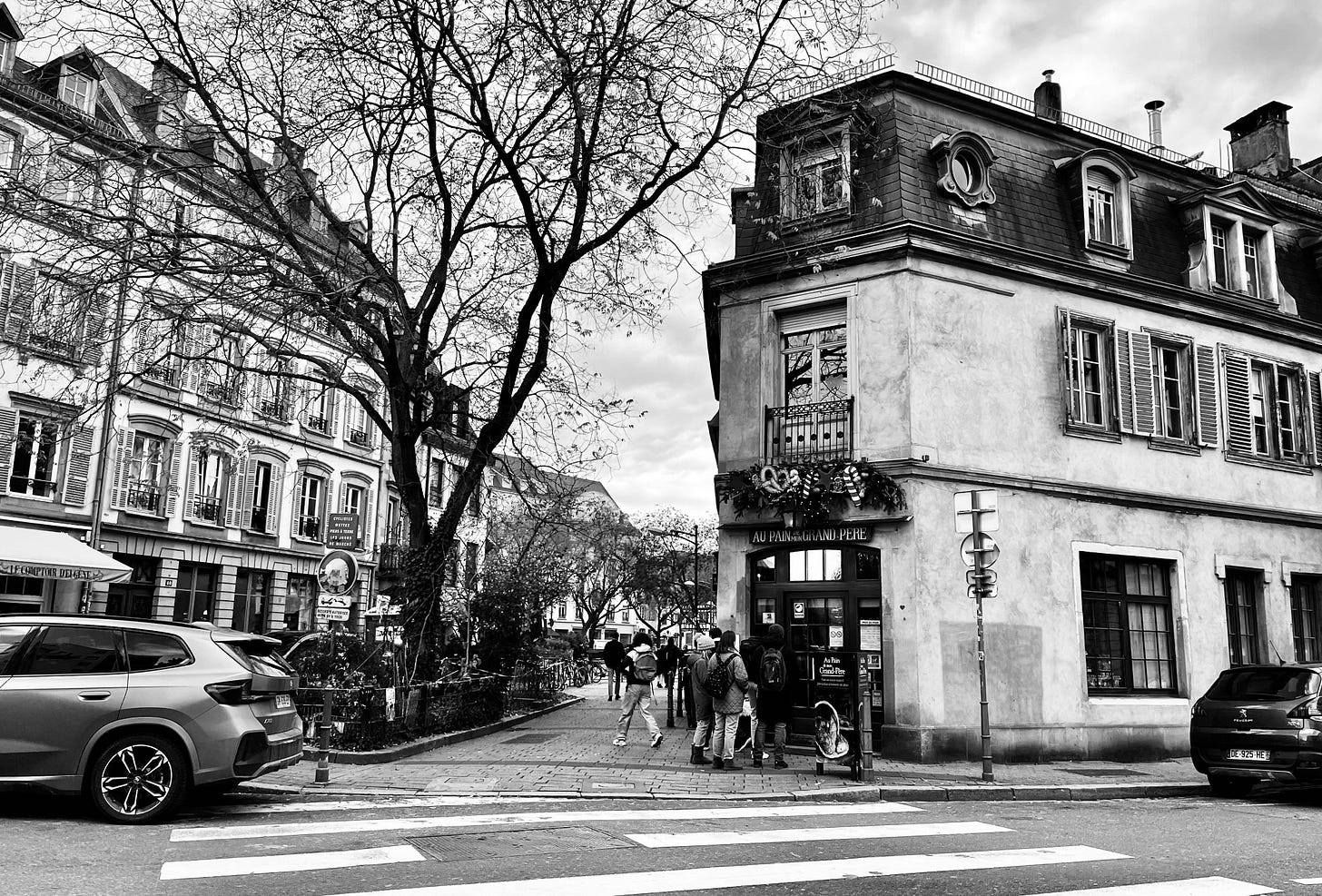
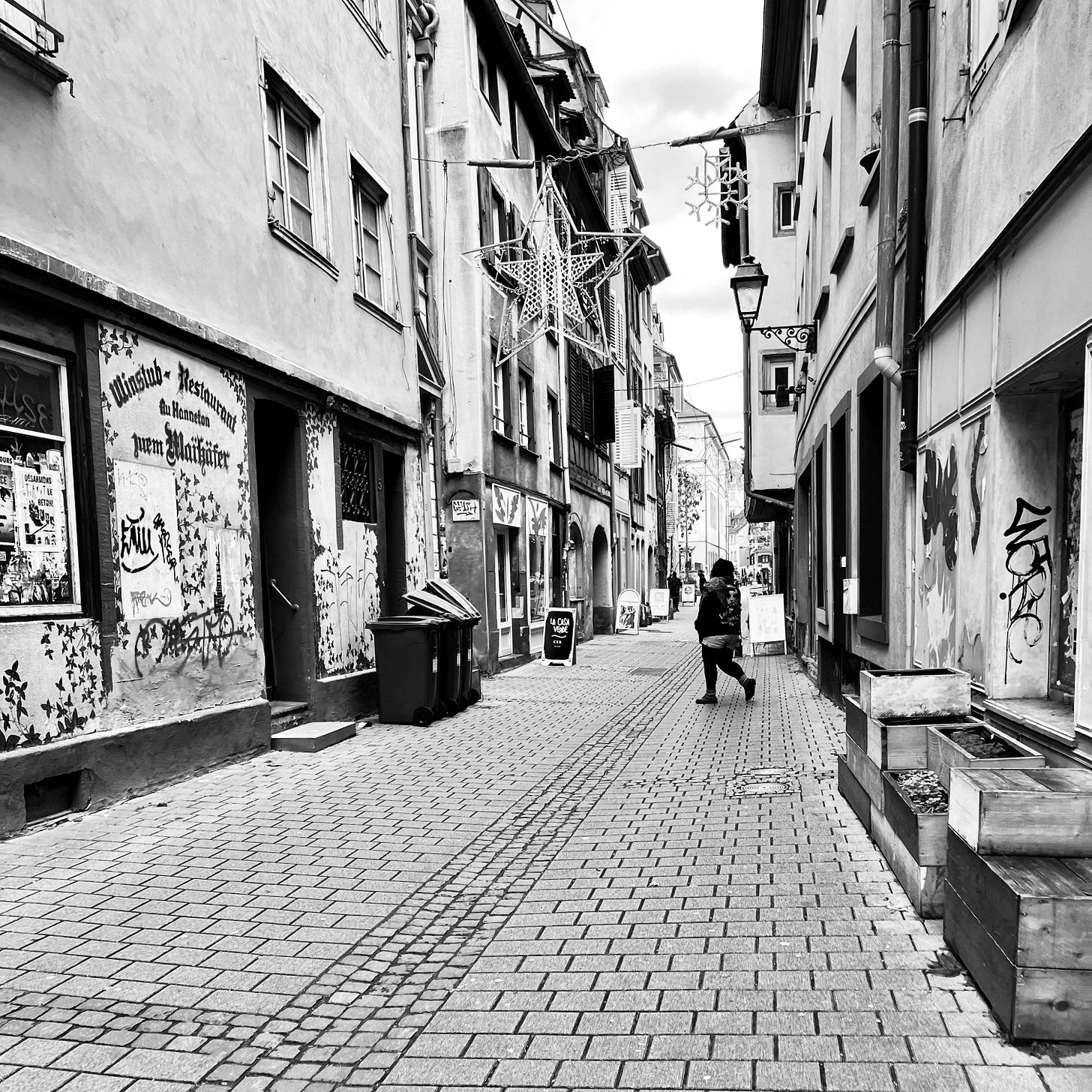
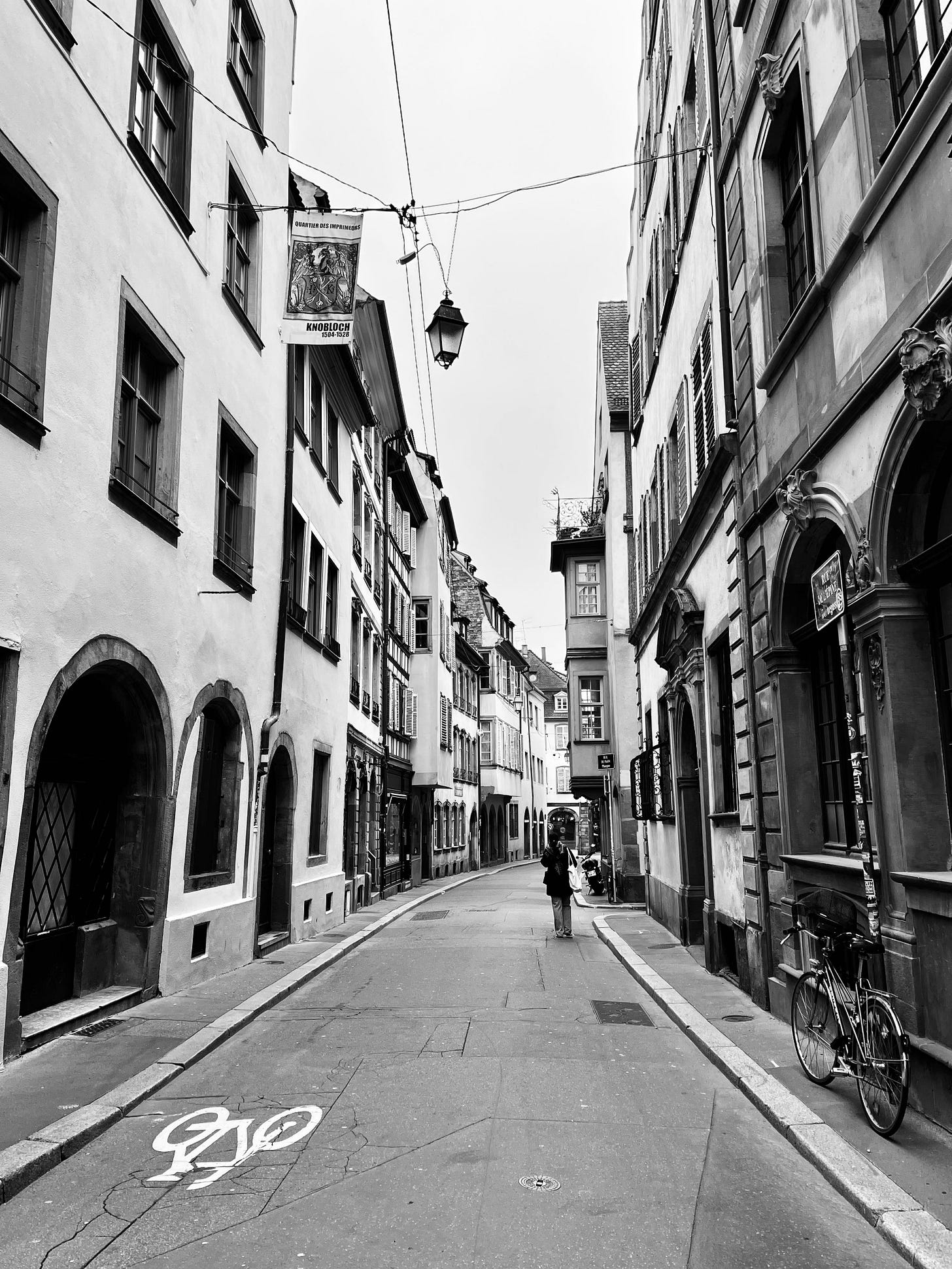
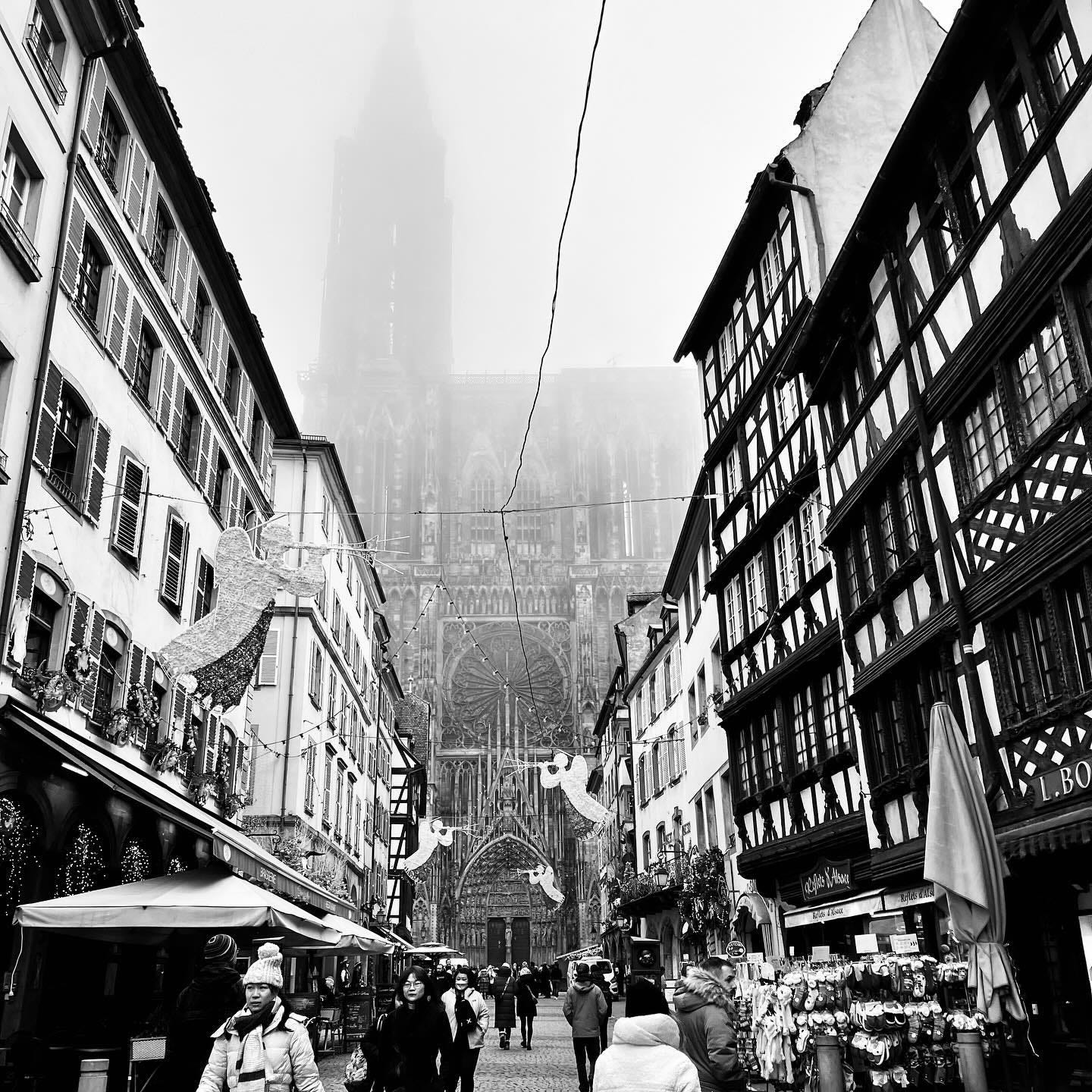
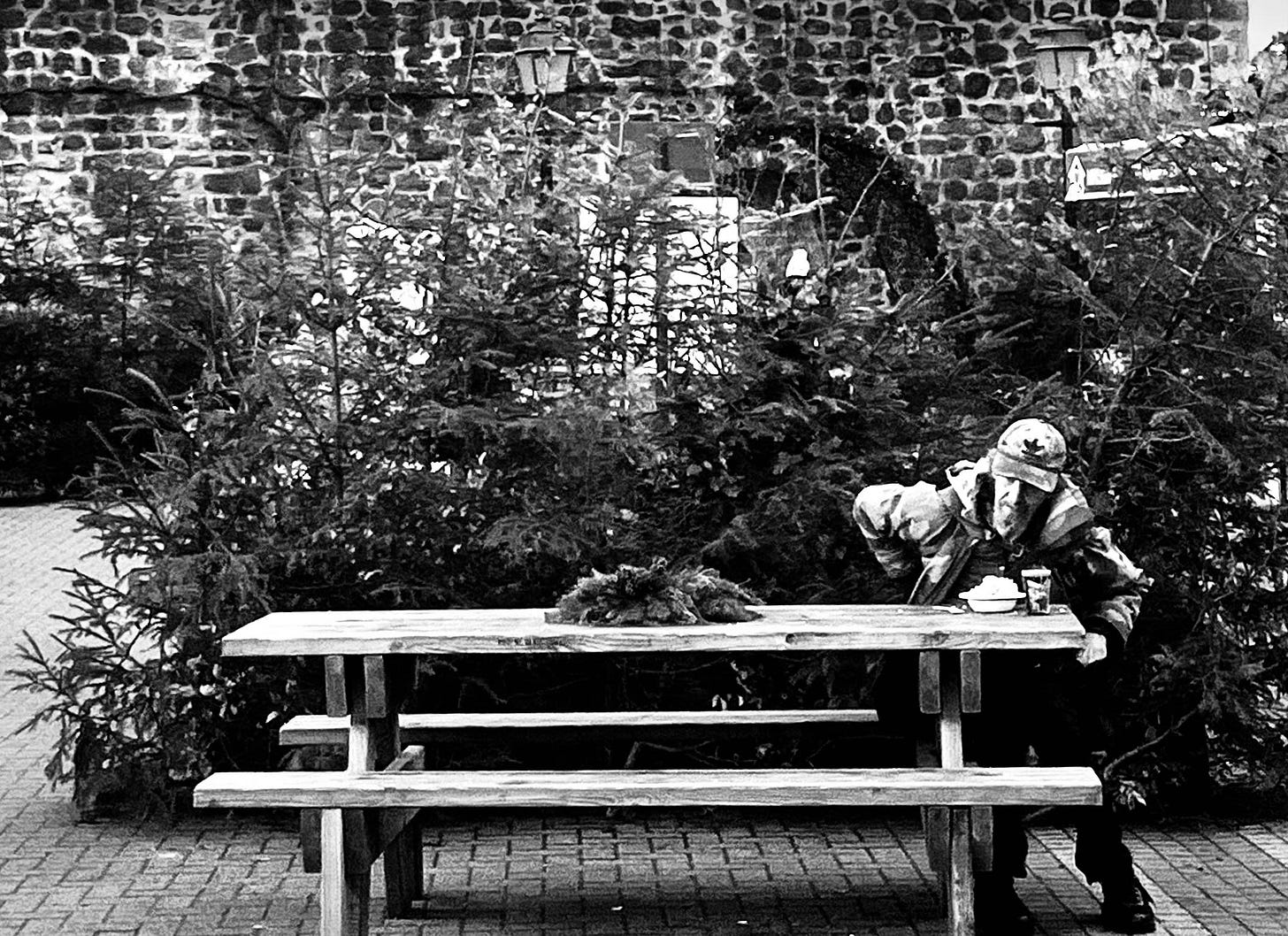
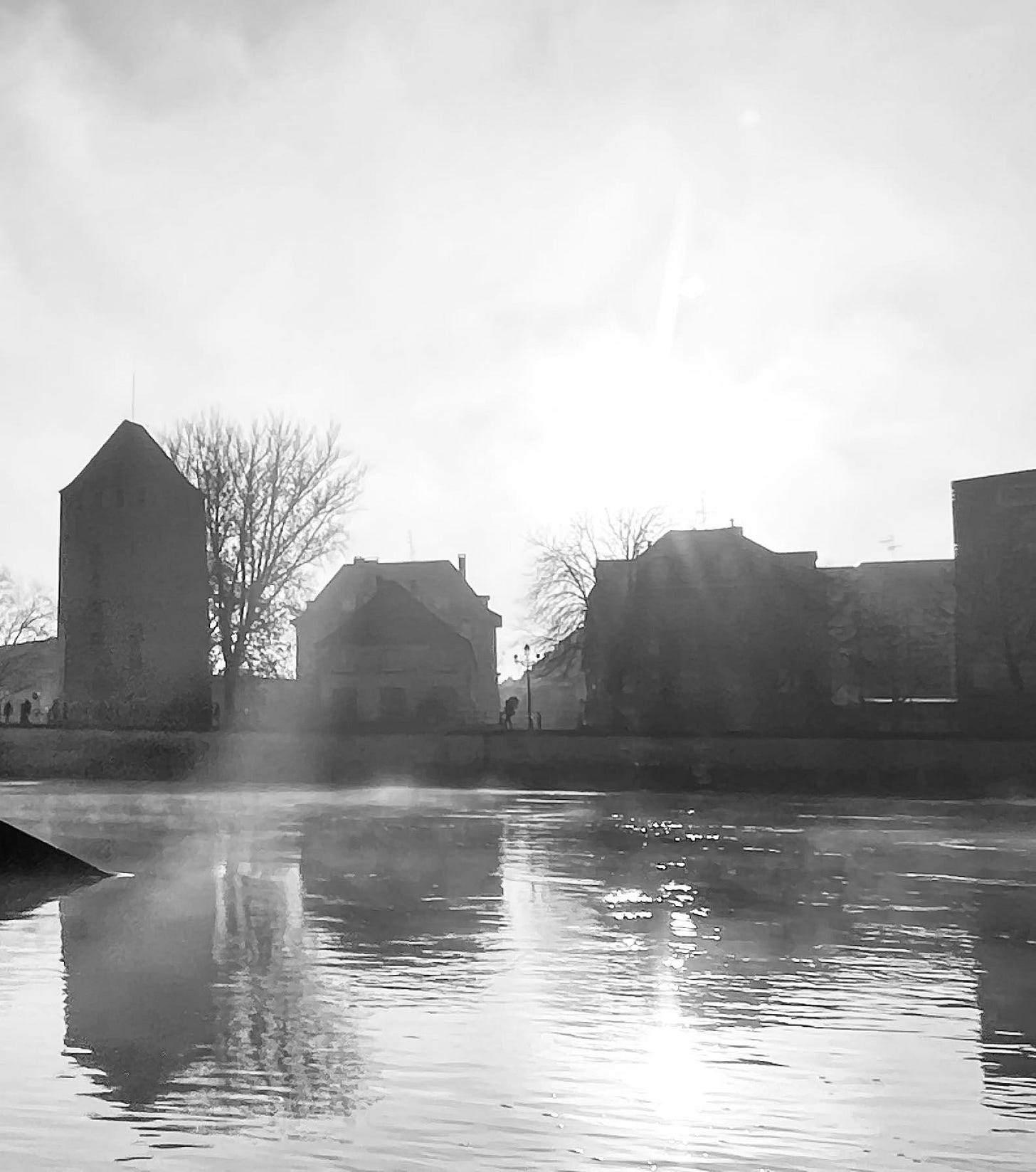

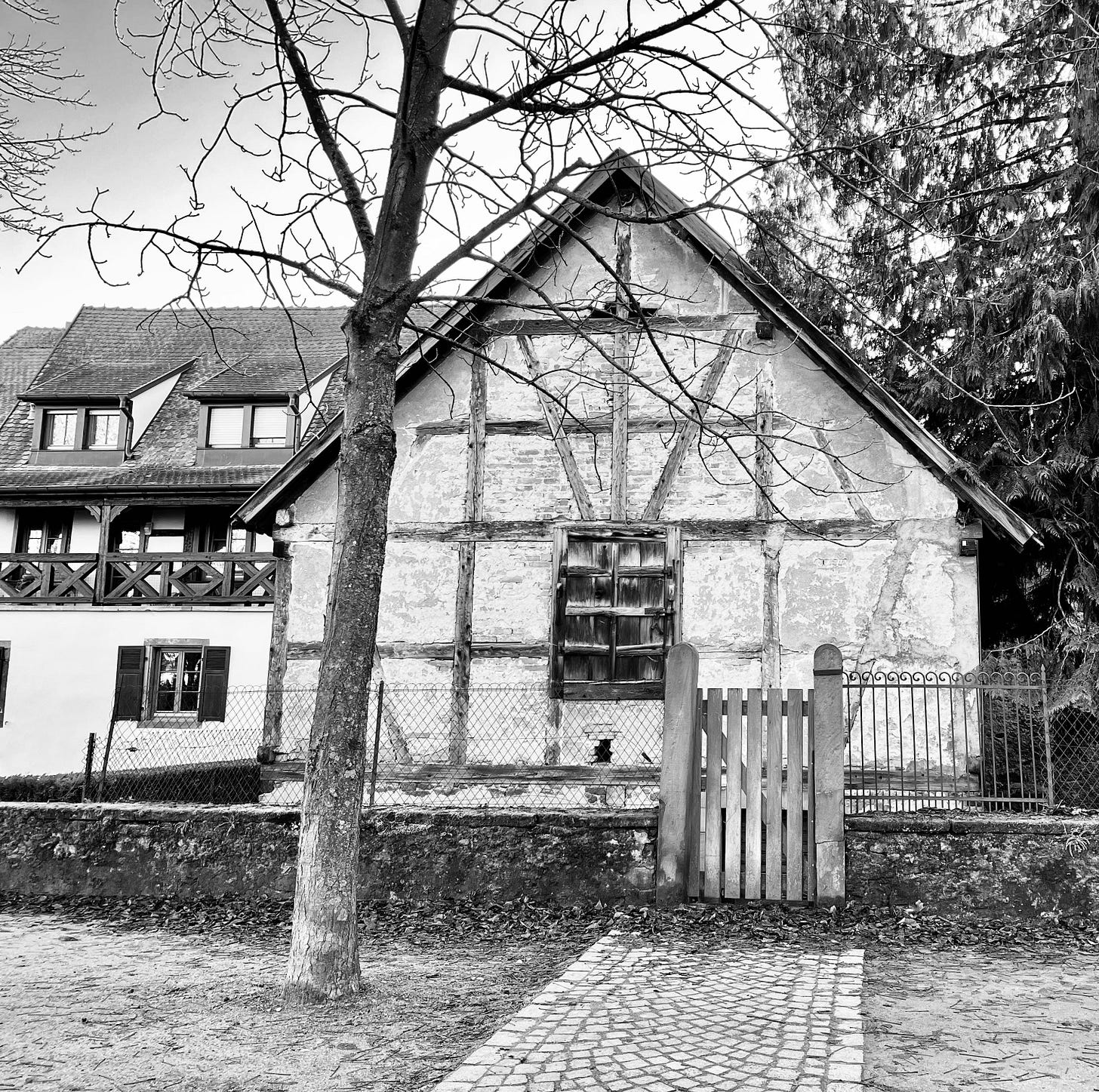
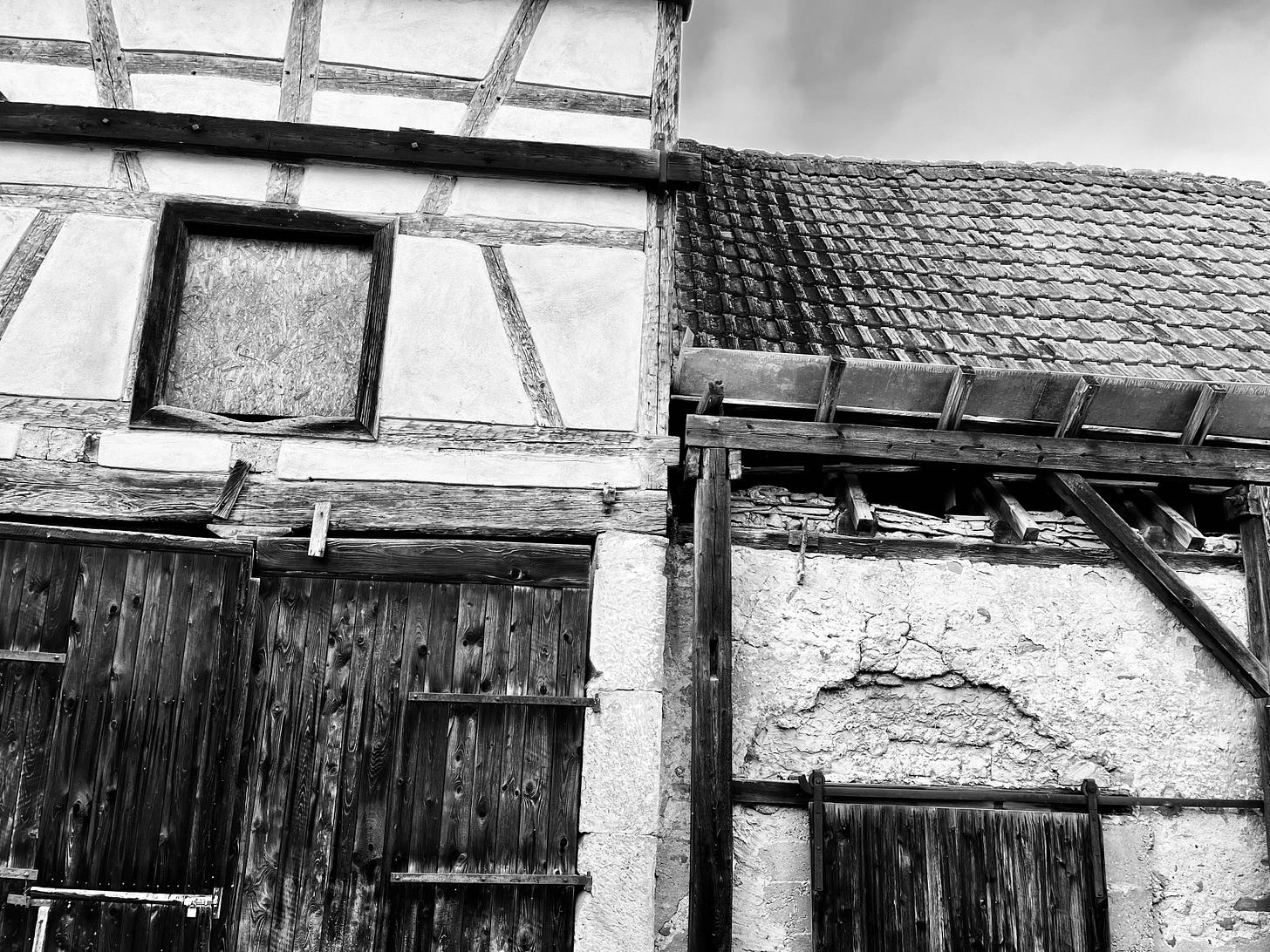


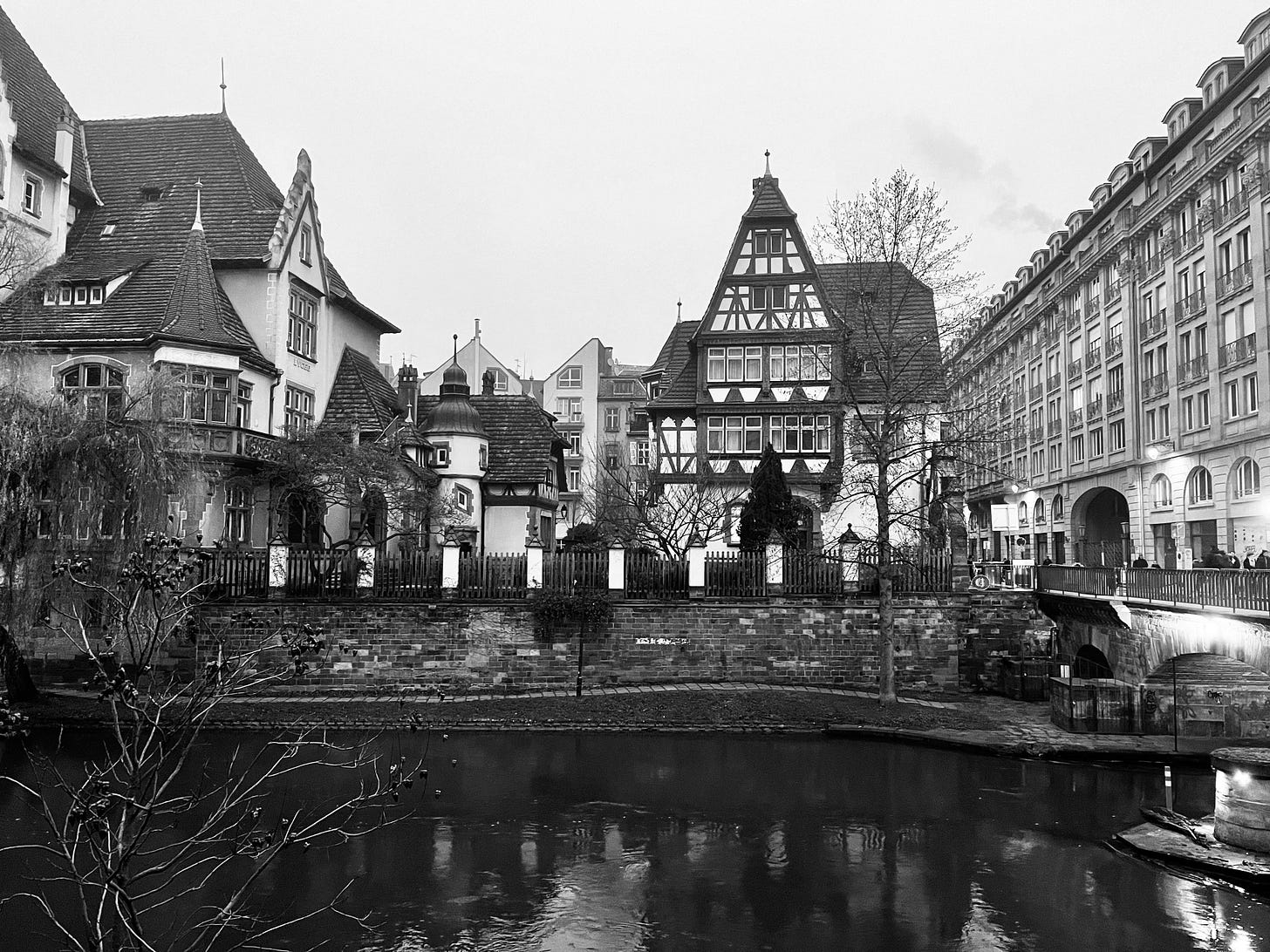
Love the interplay of images and texts here, Monique. Black and white looks terrific.
This is gorgeous, Monique.
This paragraph could have been written about JoJo and I:
"We came to travel later in life; our nest is empty and our birds have flown, and so we are flying too. But we are not bucket list travellers - we have no desire to rush from place to place. We linger longer, content to stay a few days, to spend “a lot of time in one place instead of a little time in many”. One night, after a couple of days’ exploring, of seeing this city in different lights - the grey fog, the pink sunrise, the golden glow of sunset - we talk about slow travel, and how we like to engage with whatever world we find ourselves in. We find ourselves wanting to connect, going to the same restaurant because we like the food and the people, going to the same café and grocery store, striking up conversations, looking for opportunities to test our language skills. Our story, our adventure, is not plotted in advance (aside from train travel and accommodation), but unfolds with possibility each day."
Let us know when you are in Europe next and we'll make sure we turn up to seek out the small cafe with the not-very-smiley owner with you!
Fabulous travelogue.